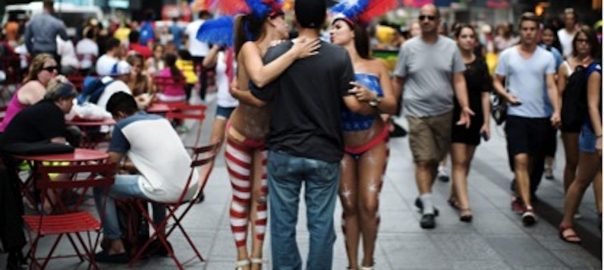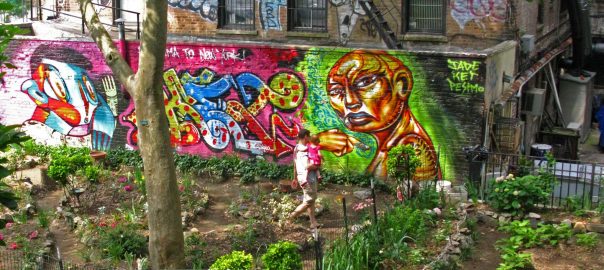1. What’s the matter with Times Square?
Several years ago, Helle Søholt, CEO of Gehl Architects, said that New York would be the most sustainable city in the world if only it fixed its streets. Million Trees NYC is one effort in that direction, as is the CitiBike bike share programme and its corresponding—if slowly-expanding and inconsistently enforced—infrastructure of protected bike lanes. But it is New York’s overall design of ‘complete streets’ that has probably been the most impactful on its sustainability profile. For years, much of Manhattan’s open space was indisputably dominated by the private car. Nowhere epitomized this better than Times Square, where pedestrians famously had to weave in and out of active vehicular rights-of-way to avoid total stoppage on the narrow sidewalks. Then, in 2009, New York decided to experiment with the pedestrianization of the area. The 2010 decision to make this permanent vaulted NYC into the vanguard of sustainable streets.

In 2015, with the plaza paved and old problems solved, new controversies are on the front page: unscrupulous hucksters and unclothed demonstrators (a return of some of the louche elements suppressed by the previous mayor, Michael Bloomberg). With the final touches of the repaved pedestrian plaza barely in place, the current Mayor (Bill de Blasio) is calling for the plaza to be removed and cars returned. A number of officials, including the City Council Speaker; the Borough President; the New York Times architecture critic; the head of the NGO, Transportation Alternatives; and others in the field of urbanism have essentially asked whether the Mayor is out of his mind. Nevertheless, de Blasio still appears to be acquiescing to the lone voice of his Police Commissioner that the redeveloped space is simply ungovernable.

Whence the drastic change? Since the installation of the plazas the empirical evidence boasts reduced pedestrian injuries and vehicle collisions (ironically, one of the aims of the current Mayor’s impressive Vision Zero), increased pedestrian traffic and increased sales and commercial rents. With such success, why would he throw it all away? Assuming that his position is not entirely capricious, we might also ask whether there is something deeper at issue. During his election campaign, Mayor de Blasio faced a right-wing critique that his pro-equity platform would return New York to the ‘bad old days’ of crime-ridden subways, drug addict-filled parks, and prostitute-frequented streets, and despite his virtual dismantling of the dreadful stop-and-frisk policy, his choice of police commissioner Bratton (and Bratton’s continuance of draconian ‘broken windows’ policing) suggest that he is still fighting the nemesis of the ‘soft on crime’ liberal label.
The problem is, that fight is getting in the way of one of the most empirically successful sustainable streets initiatives in New York’s history. For many New Yorkers, the specter of its sudden removal is unimaginable. At the same time, several years ago, many of us would never have dreamed of (as transformational a change as) the pedestrianization of Times Square. But then again, going back even further—two or three —few probably imagined a crime-free Times Square (Disney notwithstanding). Yet that, too, happened.
Taken as a whole, the various changes in and around Times Square begin to suggest a chronic pattern of reactionary responses to some of the most visible crises of the time. A series of high-profile pedestrian deaths preceded Mayor de Blasio’s Vision Zero, which since 2014 has led to lower speed limits and redesigned sidewalk curbs, including in Times Square. New York’s loss of the title of top ‘world commerce center’ to London and loss to the state government on instituting ‘congestion pricing’ (which London had successfully premiered) preceded ex-Mayor Bloomberg’s 2010 efforts to pedestrianize Times Square. And a violent crime peak while ex-Mayor Giuliani was District Attorney preceded his mayoral run, following which he cracked down on illicit activity in Times Square in 1994. The question is, could New York even dream of managing all of these challenges simultaneously? As Richard Sennett wrote earlier this year, ‘the way forward lies in urbanists stepping out of our professional confines, drawing on other disciplines, no matter how amateurishly.’
Let’s head to psychology for a moment.
2. Is it about us?
Psychologists refer us to the ‘miracle question’. It is usually phrased as ‘what would a state of perfection look like?’ and it prompts the subject to envision an ideal state of improvement that is disconnected from the status quo and any intervening impediments. However—and somewhat ironically—few subjects are motivated to ask the question unless they are acutely aware that they are already doing very badly. Behavior change often starts at the bottom. Before a subject reaches the lowest point he or she may be in a ‘purgatory of indifference’, from within which it may be difficult to recognize dysfunction. Realizing that one is seriously off course from one’s life vision, there is motivation to rediscover an internal sense of purpose. This, in turn, may provide the incentive for maintaining those improvements over time; a virtuous cycle, if you will, but not an automatic one.
New York, like many cities, does have a wavering uncertainty about how to manage public space and balance spontaneity and control, an uncertainty into which Times Square’s hucksters and Desnudas may have tapped. But perhaps they have not tapped deeply enough to motivate the city to do more than tackle its symptoms as they flare up. As a result, a fear of returning to the ‘bad old days’ seems to have subsumed the recently—if shallowly—solved problems of pedestrian injury. It is also not uncommon for a sitting mayor to erase the legacy project of his predecessor (megalomania, if you like). But does the sudden push to eliminate the pedestrian plaza also reflect a collective, self-destructive tendency? Decades ago, Rem Koolhaas suggested that Manhattan, the ‘capital of perpetual crisis’, had always been obsessed with destroying and remaking itself, in a form of collective delirium, and that it revels in its resulting ‘culture of congestion’. Does it reflect amnesia about the city’s recent past of heightened pedestrian hazards? Paranoia about its far past of runaway crime? Or just hysteria about topless women (perfectly legal in New York City, by the way) in general?
Perhaps, like so many New Yorkers, Times Square needs a shrink—that is, a psychiatrist. Its symptoms suggest the need for a paradigm shift toward a culture of sharing public space that, as city leadership changes, can be sustained over time.
3. How can we sustain behavior change?
The general principles of behavior change—what motivates, how to maintain it over time—also apply to more complex group situations. The city is a sociospatial construct, co-created between people and place, each shaping the other. Indeed, culture and behavior concretize and coalesce in public space like nowhere else. Do behavior change principles also apply to Times Square and New York: its residents, their values, the leaders they elect to represent them, the policies those leaders institute to address their priorities, the police they appoint to enforce them, the influence of the police on the behavior of people, and so on?
We believe so, but with two main differences. First, where there is hierarchy, there is a gap between decision making and those experiencing its consequences; this requires a correspondingly strong communication strategy. And second, more people means more divergent priorities; this requires a strategy for balancing them. Group therapy can help. It transforms one’s peers into ‘mirrors’ that provide increased clarity about one’s own and others’ values and priorities. The mutual vulnerability this generates often increases the intent of the group to learn and improve, rather than protect and regress. And this dynamic is key to effectively addressing deeper issues rather than superficially treating the symptoms of group dysfunction: this is the cultural paradigm shift we seek.
Over time, however, behavior change is vulnerable to relapse. The conflicting priorities and short-term electoral cycles of cities only exacerbate this tendency. A maintenance plan can help, particularly where earlier motivation has disappeared. The technique of motivational interviewing, developed by clinical psychologists William Miller and Stephen Rollnick, gives some guidance on sustaining behavior change over the long term. It works by eliminating conflicting motivations that are inconsistent with the subject’s deeper values. Unless such ambivalence is resolved, behavioral relapse remains a serious risk. Motivational interviewing has five stages: precontemplation, contemplation, preparation, action, and maintenance.
As change is a process rather than an outcome, progression through the stages is not always linear. In that sense, periodic maintenance may be the most critical stage. How does it work? Psychologists cite three key factors. First, social support, which carries the decision maker through the detours of the change process. Second, public announcement of the plan to change, which encourages accountability. And third, the creation of an escape plan early in the change process, which preemptively anticipates threats and prompts appropriate coping strategies, improving its long-term prognosis.
4. Three cities’ change trajectories
Can behavior change interventions positively influence sustainable urban improvement? And can they bring attention to invisible solved problems as much as visibly unsolved ones, particularly in light of electoral cycles and short-term memory? How does the experience of other cities speak to this? Let’s have a look.
Curitiba
That the city of Curitiba features very high on last year’s inaugural The Competitiveness of Cities, published by the World Economic Forum, will not surprise anyone. Curitiba also ranks at the top of the Latin America Green City Index sponsored by Siemens. For many, the city’s name is synonymous with sustainability. Less talked about is the significant obstacles the city overcame and whether its formerly dire sustainability situation might have motivated its current ‘best in class’ status. Four decades ago, Curitiba’s exceptionally high population growth and declining landfill capacity yielded an unmanageable non-organic waste surplus. (In motivational interviewing terms, one might call this the city’s precontemplation stage.) This was most acute in the city’s burgeoning hillside favelas. Here, there were so few streets that garbage vehicles could barely penetrate the built fabric to clear its growing refuse piles, the runoff from which was contaminating adjacent water bodies. As vermin and disease spread, the city debated how to act. (This suggests the contemplation stage.)

These rock-bottom conditions prompted the city to take action that ultimately led to a low-cost, world-leading waste management system. Its communication strategy was to educate children to be the agents of change who would encourage other residents to separate their garbage (reasonably tagged as the preparation stage). This Garbage Purchase program encouraged neighborhood associations to manage waste collection containers at the peripheries of hard-to-access favelas, with the incentive that each bag of sorted garbage yielded one bus ticket (clearly the action stage). There were early complications with this arrangement, but the city levered a new challenge—in the form of the 1991 cholera epidemic and its agricultural surplus—to strengthen and sustain its original improvement in the form of the Cambio Verde program, which matches sorted recyclables with local produce (arguably part of the maintenance stage, even if unorthodox). To date, Curitiba has a nearly 100 percent recycling rate.
Kitakyushu
Kitakyushu is another high performer, but one that actively touts its dramatic rise from environmental catastrophe several decades ago. In the 1960s, the city developed into one of the largest industrial cities in Japan. Lacking environmental safeguards, its adjacent Dokai Bay became so contaminated from industrial wastewater that it was soon referred to as the ‘Bay of Death’ after one study showed that even the bacteria normally endemic to saltwater bodies could not survive there (perhaps the precontemplation stage). The air fared no better. Skies were said to be filled with coal dust and ‘seven colours of smoke’ from red iron oxide particles, which alerted the public to the gravity of the situation (contemplation). Today, however, Kitakyushu bills itself as the ‘world capital of sustainable development.’


How did they do it? First, the city prepared for large-scale change by capitalizing on many residents’ firsthand experience of the pollution to motivate and align interest groups to a common goal then communicated their purpose to increase public understanding and support (preparation, clearly). Then it acted by instituting voluntary pollution agreements with the private sector, setting stringent new pollution reduction targets, dredging the bay, creating pollution surveillance centres and building a model eco-town (most certainly action). Kitakyushu maintained momentum over the long term with a second phase plan focused on the new goal of reaching zero-emissions/zero-waste status through improvements in renewable energy and green space (maintenance, in a variation from Curitiba).
Copenhagen

Also at the very top of the European Green City Index, Copenhagen is a model for non-motorized transit in cities worldwide. But its trajectory is more circuitous. By the mid-20th century, urban cycling culture was widespread. But as incomes and car ownership rose in the 1960s, the city experienced a sharp modal shift toward driving (precontemplation). Traffic worsened and car parks mushroomed; even Copenhagen’s Strøget, now famous as a completely pedestrian street, was filled with cars. Change had occurred over a sufficiently quick period that the marked increase in street collisions and air pollution were perceptible. A number of protests catalyzed the eventual reintroduction of the balanced streets of Copenhagen’s pre-car era (contemplation moving into preparation).

Copenhagen took advantage of the oil crisis of the 1970s to introduce Car-Free Sundays (preparation moving into action). In the 1980s, however, the city made a number of proposals to bisect its periurban lakes with arterials connecting the city centre to its suburbs. This clear danger had the effect of motivating continuous pro-cycling advocacy over the next several decades, during which time a permanent network of pedestrianized streets and protected bike lanes grew (action). This change, which has been sustained through today, is in large part the result of reawakening consciousness of and pride in a historical culture of sustainable urban transport. And the cultural reversion has been instilled as a daily commuting practice by half of its residents, across all social strata (maintenance). Recently, the city has even assigned 50 police to ensure that ‘cycle karma’ (courteous cycling behavior) is maintained (further maintenance).
5. What do we need to do in New York?
Can we apply these cities’ successful experiences to Times Square? All three show that doing badly is an excellent initial motivator and can vault a city to the top of the pack. All three have managed to maintain behavior change over time in ways that at least roughly validate Miller and Rollnick’s motivational interviewing model. And all three now enjoy visibility at the top of several high-profile urban sustainability and performance indices. To secure continuous improvement over many short-term electoral cycles, these cities actively anticipated future threats and mined their cultural memory for retrievable opportunities. All of the above could help New York actively address its conflicting priorities and shift its public space culture.
New York comes in third in the Siemens North American Green Cities Index; first in the subcategories of land use and transport (undoubtedly reflecting its density and public and non-motorized transit infrastructure). Density and transport infrastructure require the appropriate complement of public space, such as Times Square, to function viably, but the rankings may constitute a negative incentive if these are seen as ‘mission accomplished’ and attention shifts elsewhere. Indeed, the renewed focus on ‘broken windows’ policing of public space suggests that the design priorities of the last administration have taken a back seat to the policing priorities of the administration before that. It is as if Times Square has zig-zagged through the stages of behavior change with three short-circuited cycles of preparation into action, each lacking the necessary contemplation and maintenance stages.
Times Square is not a failure of planning and design, or lacking in sustainability metrics, and certainly not suffering from an underequipped police force. On the contrary, it is a failure to address the deeper conflicts that public space embodies. New York may agree to disagree on the small stuff—what Sennett refers to as ‘difference and indifference’—but it must come to a broad agreement on big values, values such as justice and obscenity, which underlie ‘the right to the street’. Unless it does, the over-reactionary behavior will continue and the physical fabric of Times Square will likely suffer anti-human consequences.
If Times Square were to get a shrink, s/he would undoubtedly first say ‘the answers are within you’. Within whom, though? The public, the mayor, and the police force represent a promising first step. The paradigm shift we seek will require all of them to undergo a behavior shift; one that would benefit from a motivational interviewing intervention if it is to last. What would that look like?
The public
The general New York public is most responsible for actively cultivating the values and priorities (i.e. resolving the ambivalence) underlying public space culture. Too much of New York has lazily acquiesced to increased security at the price of decreased freedom (e.g. stop-and-frisk), in part because most of the public doesn’t see such policies as the Faustian bargain they are until they are directly targeted in the street. Vision Zero has directly benefited a majority of New Yorkers as well as tourists; however, those benefits may not be obvious to those who commute in private cars (nor even to pedestrians once they step into a cab). These members of the public may see the Times Square pedestrian plazas as little more than an obstruction, and though their attitude and behavior is out of sync with the majority of the city, they are still part of—and have an outsized impact on—daily urban function.
These issues might be handled best through better precontemplation and contemplation, which would help the public understand that change is necessary and then help it resolve its ambivalence toward core public space issues. What might the public contemplate? For starters, why do we consider a bare female nipple obscene, but not a toddler killed by an SUV that fails to yield to it on a crosswalk? How is it just for 25 percent of those using the street (from within a car) to occupy 75 percent of its area? Do we really want to arrest people for actions that merely shock our sensibilities (and have we considered how that might that backfire)? As Sennett puts it, are ‘isolation and segregation better than the risks entailed in interaction?’ ‘[C]ommunities have to decide […] [b]ut this is a decision which…should result after the experience of…exposure to difference rather than flight from contact.’ Such a process must also proactively deal with the person who is paranoid about crime, hysteric about nudity and narcissistic about parking his SUV in a protected bike lane.
The Mayor
Mayors are heavily incentivized by the prospect of being reelected by the public. This is not inherently bad, but their zeal to prove themselves strong leaders should not necessarily mean erasing the successes of their predecessors. Mayoral priority setting would benefit from a strengthened process of contemplation. Much of the Times Square pedestrian plaza’s benefits contribute directly to reducing the risk of pedestrian injury and death, which are overarching aims of Mayor de Blasio’s own signature effort, Vision Zero (which even revived and won a decades-old battle with New York State to reduce the speed limit throughout New York City from nearly 50 km/to 40 km/hr [30 to 25 mph]). But Vision Zero needs to lead a wider, long-term cultural shift, rather than simply establishing a new law and set of design precedents. If it does not, it may die an early death in the hands of de Blasio’s successor.
De Blasio would also do well to contemplate New York’s long term cultural legacy. From its genesis, the city was the cosmopolitan, tolerant ‘New Netherland’. The continued viability of Times Square as ‘crossroads of the world’ may depend on de Blasio exercising his moral force to explain these values to visitors, many of whom may be less open to encountering the unexpected—Desnudas, for example—in public space. (Bloomberg, his predecessor, once dismissed criticism of a mosque being built near ground zero by saying ‘whether you like a mosque or don’t…you don’t have to go […] within four blocks of the World Trade Center…there’s [also] porno places…I mean it’s a vibrant community, it’s New York.’ Or, as Sennett puts it, ‘[c]osmopolitanism is stimulation by the presence of others but not identification with them.’) If cities anywhere have any hope of accommodating heterogeneous groups of people, then Times Square needs to continue transcribing the ideals contained in New York’s DNA.
The police
Rather than the Mayor, though, it is the police that regularly interact with the public. Though the NYPD advertises ‘courtesy, professionalism, respect’ as its motto, how many members of the police force share those values? Officer Frascatore’s recent body-slamming of James Blake—one of a long string of abuses that have gone unpunished by Bratton—suggests that the advertisement seeks to compensate for the very attributes the NYPD lacks. Though the police remain exempt from city residence requirements, they must still have respect for the values of those actually living here. Some form of group therapy might help them overcome their defensive posturing and to listen to what security and quality of life really mean for the resident public. But Police Commissioner Bratton and his force cannot be part of the change process until they start enforcing laws as they are: key aspects of Vision Zero, such as the right-of-way law, are still widely unenforced, while legal acts, such as toplessness, continue to be punished.
Bratton continues to argue that ‘broken windows’ policing preempts more serious crime down the line, but action without contemplation or preparation is rarely effective in the long term. Making something unpleasant illegal does not make it disappear, much less address its deeper causes. The NYPD also needs to reconsider the justice in catching all guilty at the price of harming many innocent and end its quota system, which incentivizes arrests. Though this may be difficult in a post-9/11 era, the appalling policing situation to which it has led in this country is another ‘rock bottom’ opportunity for 180-degree behavior change. To start with, the NYPD would benefit from contemplation of the values behind proposals by the City Council to decriminalize certain low-level public space offenses—such as drinking alcohol and riding a bicycle on the sidewalk—which they currently oppose. Finally, adequate preparation would help them enforce these progressive new laws once they are adopted.
Times Square must allow for the possibility of appropriation by an unintended use or it will never evolve as public space must. ‘It is possible to contrive places and spaces which allow for the gradual evolution and opening up of rituals of behavior, so that people experience both form and change.’ Opening up the rituals of behavior will not be easy (and it certainly won’t happen within cars), but until we do, the Times Square pedestrian plaza may not have sufficient cultural support to ultimately stick. And until the average New Yorker regards cars hitting pedestrians as (preventable) collisions rather than (unavoidable) accidents, Vision Zero may also be vulnerable.
Fixing Times Square’s underlying dysfunctions might appear to be daunting. But why can’t we handle them? Other cities have handled much more (and with smaller budgets). Why shouldn’t the public space of Times Square serve as a catalyst for solving multiple systemic dysfunctions? After all, Lefebvre wisely reminded us that all social relations are merely hypothetical until they are spatialized. It is not a question of whether New York can tackle its biggest issues through public space: it is an imperative that it must.
Andrew Rudd
New York City
With inputs from Stephanie Rudd-Weigleb, LCSW, LCAC, Assistant Manager at Midtown CMHC of Eskenazi Health, Indianapolis.












Excellent essay . Particularly in the public section the relative values of various objectionable conducts resonate. i dream of collating and comparing the various offenses/penalties contemplated by our justice system. This would be the best objective description of our values system.
What is missing though is “patient Zero” : Who first complained about Times Square? How many people complain every day? To whom? is there a 311 category for Times Square or desnudas complaints ? is it a real problem or a manufactured one to agitate on a specific issue? in my role at the Community board I have learned that all complaints are not equal and who is complaining is quite important..
I have not seem this information and I suspect it does not exists. So who is agitating all of us and why?
Regards
Interesting essay, but here is the nub:
…changes in and around Times Square begin to suggest a chronic pattern of reactionary responses to some of the most visible crises of the time.
and
Mayor de Blasio faced a right-wing critique that his pro-equity platform would return New York to the ‘bad old days
Your discussion failed to mention race at all, at least explicitly, and that is what is at the heart of the American political position of fearing the “bad old days.” American culture is deeply uneasy with cultural difference, and NYC always teeters on the edge of the precipice that leads to the usual calls for “Law and Order.” We are, in many ways, a deeply reactionary country.